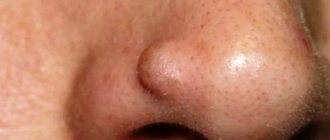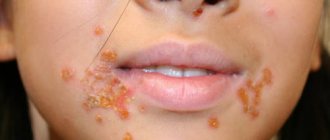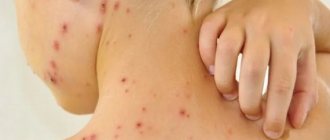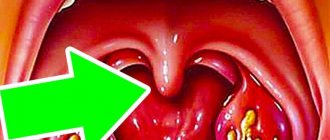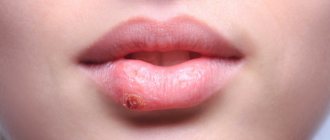What diseases cause a rash on the lips?
Pimples, redness and other signs of irritation on the lips appear for various reasons. Most often, their appearance is associated with a weakened immune system, which cannot cope with bacteria and viruses.
Rashes appear due to vitamin deficiency, frequent hypothermia and overheating, improper installation of veneers and braces. The cause may be the spread of fungus.
A rash on the lips may indicate the development of:
- Herpes - the disease is provoked by a virus, usually type 1. With this pathology, the rashes become regular and look like groups of small bubbles filled with liquid. Their appearance is accompanied by itching and pain;
- Allergies to cosmetic products, toothpaste, substances contained in food. A feature of rashes of allergic origin is swelling, and at the same time redness appears on the skin;
- Oral dermatitis - the rash is quite profuse, accompanied by peeling and sometimes a decrease in skin sensitivity. The cause of the pathology is disturbances in the functioning of the nervous system, the use of low-quality cosmetics, skin hypersensitivity, prolonged exposure to a solarium or exposure to the sun;
- Fordyce's disease - the disease manifests itself in connection with the expansion of the sebaceous glands against the background of hormonal imbalance and manifests itself as white granules or nodules.
When the rash is accompanied by cracks, peeling, and yellow crusts are visible on the lips, this may indicate cheilitis. The disease progresses due to genetic predisposition, frequent stress, exposure to ultraviolet radiation, and hypovitaminosis. Neoplasms in the form of ulcers with bleeding may turn out to be malignant.
Yellow discharge in women and purulent rash
Purulent rashes may appear on the labia and mucous membranes of the vulva. This is a sign of a bacterial infection. The clinical picture is usually complemented by yellow vaginal discharge. Gradually, acne spreads to the pubic area, causing folliculitis (ulcers on the hair follicles).
The pathology is easily treated - antibiotics, local antiseptics, drugs for immunity. However, the disease is dangerous because the infection spreads to the deeper layers of the skin. A boil forms at the site of damage to the fatty tissue. The formation is dense and painful. The pain radiates to the abdomen and rectum.
Often the formation of a subcutaneous boil ends in bartholinitis. This is an inflammation of the reproductive gland in the vestibule of the vagina. With bartholinitis, a large formation appears at the vaginal vault, which hurts and interferes with movement. Bartholinitis is treated surgically - the formation is opened, the pus is removed and washed with an antiseptic.
Is a rash on the lips contagious?
The cause of the rash on the lips determines whether the disease can be transmitted to others. Herpes is transmitted through contact with body fluids or damaged tissue of an infected person. With noticeable lesions, the virus is especially dangerous, but its transmission is also possible in the asymptomatic stage. You can become infected through a kiss or utensils used by the carrier of the virus.
Allergies and oral dermatitis cannot be transmitted from one person to another. The same applies to Fordyce's disease, cheilitis.
Common symptoms and manipulations in dermatology:
- Skin rashes
- Calling a dermatologist to your home
- Itching in the urethra
- Itchy skin
- Skin rash
- Prevention of casual sex
- Skin neoplasms
- Pyoderma
- Pityriasis rosea
- Streptoderma
- Scabies
- Peeling skin
- Fungal infections
- Skin infection
- Pus on the skin
- Blisters on the skin
- Papillomas on the foreskin
- Sexually transmitted diseases
- Skin structure
Primary herpes
There are three periods of illness:
- Prodromal
(precursor period), during which the temperature rises, the inguinal lymph nodes become inflamed, weakness, fatigue, and headache appear. A person experiences a condition similar to the symptoms of flu and colds. If you take an antiviral drug during this period, the disease may not develop. If the symptoms are ignored and treatment is not started on time, the second period of the disease begins. - A rash
that occurs three to four days after the onset of a flu-like condition. Common symptoms include pain, heat, swelling, itching in the genital area, anus, buttocks, pubis and perineum. Soon, numerous blisters filled with clear liquid appear on the inflamed skin and mucous membranes, reminiscent of a “cold” on the lips. The rash causes pain and itching, worse at night and leading to insomnia. - Ulcerations.
After some time, the blisters burst and ulcers (erosions) form in their place, surrounded by a focus of inflammation. Contact with stool and urine on the eroded surface increases pain and complicates tissue regeneration. - Healing,
during which the ulcers gradually heal. If the genital organs are poorly cleaned, the immune system is weak, and infection occurs, the healing process is delayed.
After the ulcers disappear, the disease goes into remission. During this period, despite the presence of the virus in the body, there are no rashes on the genitals.
Which doctor treats a rash on the lips
A rash near the lips can be a dangerous symptom. If such manifestations occur, you should definitely visit a doctor, undergo prescribed tests and, if necessary, a course of treatment. First, you should visit a dermatologist, who will prescribe diagnostic procedures to identify the disease.
Even if the test for herpes is positive, many more parameters are taken into account when prescribing therapy: the number of antibodies, the stage of the disease, the individual characteristics of the body. This disease has 8 varieties, and appropriate treatment is selected for each.
If a reaction to certain substances and products develops, consultation with an allergist is required. There is often a need to visit an immunologist, since most diseases associated with a rash on the lips progress against a background of weakened immunity. But you should not visit the dentist if you have such symptoms. During dental treatment, the vesicles can become damaged and become infected, which causes inflammation and complications.
Causes of cheilitis
The inflammatory process can begin for multiple reasons. One of the most common of them is mechanical injuries: for example, accidental biting can cause inflammation.
The development of the disease can also be provoked by:
- unfavorable environment (people who spend a lot of time outdoors and are exposed to wind, frost and other weather conditions are more likely to suffer from cheilitis);
- aggressive action of cosmetics or an allergic reaction to some of their components;
- lack of vitamin B2, which is responsible for the division and growth of epithelial cells;
- diseases of the gastrointestinal tract, liver, lack of immunity.
Ointments that are used for rashes on the lips
A qualified doctor should select medications to treat rashes. Attempting to get rid of unpleasant symptoms on your own will, at best, relieve the symptoms without eliminating the cause of the problem. At worst, the situation will worsen.
A rash on the lips caused by the herpes virus is treated with antiviral drugs - for external use or for oral administration. The following ointments are used:
- Acyclovir (Virolex, Zovirax, Acyclostad, Herperax, Gerpevir, Provirsan) is an antiviral agent that penetrates the DNA chain of the virus and stops its replication. However, over time, the effectiveness of the drug decreases, so its use requires justification;
- Penciclovir (Vectavir, Fenistil Pencivir) - enters infected cells without affecting healthy ones. Prevents viral DNA synthesis;
- Docosanol (Gerpanit, Erabazan, Priora) - prevents the connection of the virus with the cell membrane, is prescribed in the initial stages of the pathology.
For Fordyce's disease, ointments with retinol are used. For cheilitis, you need to use corticosteroid ointments - Prednisolone, Flucinar. The treatment regimen for oral dermatitis usually includes the use of metronidazole cream or gels, clindacimine, erythromycin, azelaic acid products, and pimecrolimus cream.
Answers to frequently asked questions about skin rashes:
- Which doctor should you contact for a skin rash?
- Is the skin rash contagious?
- What diet is necessary for skin rashes?
- What diagnosis is needed for a skin rash?
- Why is a skin rash dangerous?
- Why is it necessary to get tested for a skin rash?
- What diseases does a skin rash indicate?
- What examination is necessary for a skin rash?
- Which skin rash is dangerous?
- How to distinguish an allergic rash from an infectious one
- How to get rid of skin rashes?
- How to get rid of itching skin rash?
- What organs are affected by a skin rash?
- How to prepare for an appointment with a dermatologist?
- How to get checked for skin diseases?
- What diseases does a dermatologist treat?
- What tests should be taken by a dermatologist?
- What diagnostics can a dermatologist perform in the clinic?
- Where to go with a skin disease?
Types of rashes on the lips
Rash on the lips can be of various origins, and externally such skin lesions differ in character, color and other characteristics. The rash can be classified as:
- Blisters are small formations with hemorrhagic or serous contents, their size is 4-5 mm;
- Bubbles - formations with a diameter of 5 mm to several centimeters, usually indicate a long course of the disease;
- Pustules are red or pale pink, filled with pus. They can be located not only on the surface, but also deep under the skin;
- Spots – redness of small areas of the skin;
- Nodules and nodules that can leave scars;
- Erosion and ulcers are neoplasms that violate the integrity of the skin and have transparent or cloudy contents.
Allergic reactions lead to the appearance of small bright pimples, swelling, and edema.
Rash on lips in pregnant women
During pregnancy, certain prerequisites arise for the activation of the herpes virus. The body perceives the fetus as something foreign, and to prevent its rejection, maternal immunity is automatically reduced. The main symptom of the disease is a rash on the lips.
The disease can be primary or recurrent, the effect of the virus on the unborn baby depends on this. If a woman has previously had herpetic manifestations, the probability of danger to the fetus is estimated at approximately 5%. This is explained by the presence of specific antibodies in the blood. If the body has not previously been infected, the risk of fetal pathologies increases markedly.
But a rash on the lips of a pregnant woman is often a sign of hormonal changes in the body, especially in the early stages. The main reason is an increase in progesterone production. Such conditions are not dangerous for either the mother or the child.
Allergies also do not pose any risks to the fetus: the placenta provides reliable protection against allergens and antigens, as well as antibodies that are produced to suppress them. All these substances do not get inside the fertilized egg.
Herpes in newborns
A child becomes infected with the pathogen from the mother in utero or by passing through an infected genital tract during childbirth. In newborns, the mucous membranes of the eyes and mouth, skin, and genitals are affected. When the pathogen enters the child’s brain, meningoencephalitis occurs, causing death or severe disability.
A generalized form is possible, in which all organs and systems of the newborn are affected. The child experiences jaundice, respiratory distress, and urinary retention. Children are restless, do not latch on to the breast, and are vomiting. Death occurs from shock, bleeding, dehydration, intoxication, and organ failure.
The likelihood of infection increases with primary infection of the mother in late pregnancy.
Prevention of lip rashes
In order to prevent rashes on the lips, it is necessary to maintain the immune system in a normal state: eat well, give up bad habits, engage in physical activity, harden, minimize the influence of stress and hypothermia. As recommended by your doctor, you should take multivitamin complexes or individual vitamins to prevent their deficiency in the body.
To prevent herpes you need:
- Wash your hands thoroughly after contact with affected skin areas;
- Do not use other people’s hygiene items and store your own items separately;
- Use individual dishes;
- Avoid kissing your partner while the virus is active.
The use of high-quality cosmetics and careful diet control will help prevent allergic manifestations. If the diagnosis reveals the body’s reaction to certain foods, it is necessary to stop consuming them. During periods of exposure to the sun or visiting a solarium, you should use special protective creams.
Causes of rashes in the intimate area
The content of the article
In women, rashes of various types most often appear on the pubis, genitals, and perineum. These can be ulcers, spots, pimples and other visually noticeable skin lesions. These manifestations may be associated with frequent shaving, mild allergies, and poor hygiene. However, quite often rashes in the intimate area require medical attention, as they become a response to infection.
The appearance of an unpleasant rash in the intimate area is associated with the following factors:
- Infection
. The nature of the rash depends on the type of infection that is actively multiplying in the body. Infection with a sexually transmitted infection is usually accompanied by additional symptoms. This may include purulent discharge, itching in the groin, and menstrual irregularities. - Weakening of the immune system
. This factor allows opportunistic flora to actively reproduce. Chronic diseases, antibiotic treatment, chemotherapy, childbearing, and hypothermia seriously weaken the immune system. - Chemical burn
. Aggressive substances destroy the upper layers of the epidermis. The body responds to this with the appearance of small, painful pimples. - Synthetic underwear
. Sometimes it causes genital allergies. Poor quality fabric does not allow the skin to “breathe”, which leads to the proliferation of pathogenic flora; - Ignoring hygiene rules
. This creates favorable conditions for viruses and bacteria to enter the body. It is especially important to carefully observe intimate hygiene during menstruation.
Why is a rash on the lips dangerous?
The degree of danger of a rash on the lips and the likely consequences are determined by the causes of this manifestation. For example, the herpes virus is integrated into the genetic apparatus of cells, rashes appear not only on the face, but also in any places where there are nerve endings. This leads to disruption of the functioning of internal organs. If left untreated, a secondary bacterial infection develops and the wound begins to fester. With a serious decrease in immune defense, herpes can cause dangerous diseases, such as encephalitis.
Allergic reactions also pose certain health risks. With allergies, the body produces antibodies to specific proteins that the allergen contains. Due to the formation of biologically active substances, the heart rate may increase, smooth muscle spasms may occur, and edema may develop. The most dangerous manifestation of the pathology is anaphylactic shock - swelling of the larynx, which can even lead to death.
It is easier to treat any disease at the initial stage, while the pathology has not yet caused significant harm to the body. That is why, if a rash occurs on the lips, you should not try to disguise it or cure it yourself. The best solution would be to visit a doctor who will diagnose and prescribe adequate treatment.
Recurrent herpes
In 50%-70% of people the disease becomes chronic. This is facilitated by:
- untimely or incorrect treatment;
- decreased immunity, including that caused by taking medications that suppress the immune system;
- presence of other STDs;
- strict diets, vitamin deficiencies;
- state of chronic stress.
Why do patients develop relapses, during which the disease affects the same parts of the body? There are several reasons for this:
- Having penetrated the body, the virus settles in the tissues of the genital organs. As it multiplies, it affects cells deeper and deeper until it reaches nerve cells - neurons connected to each other by processes - axons. Through them, like bridges, the pathogen reaches the cells of the spinal cord, into which it introduces its DNA.
- An infected brain cell becomes an “incubator” for viruses, which periodically return via axon bridges to the mucous membrane or skin, causing new rashes. Schematically, the process is similar to the migration of birds, constantly returning to their “native places.”
- The immune system cannot kill viruses hidden in the spinal cord, but it deals with those that have left the “shelter”. Therefore, with high immunity, relapses occur rarely or not at all. But as soon as the body “loses its vigilance” - weakens, gets sick, catches a cold, is exposed to stress - the pathogens begin to overcome the immune defense. As a result, they reach their target - the skin and mucous membranes of the genital organs. Here, the increased reproduction of viral particles inside the “captured” cells begins. Cellular structures, dying, release myriads of viruses that cause inflammation, redness, swelling and the appearance of blisters. Herpes is causing another aggravation.
- Gradually, the immune system fights back the virus, and within 10 days the ulcers at the site of the rash dry out and heal. Everything returns to normal, so that at the slightest weakening of the immune system it can start again.
From the mechanism of exacerbations, it becomes clear why herpetic eruptions appear in the same places. It’s just that the virus cells return back only through the nerve cell from which they penetrated deep into the body.
Types of recurrent herpes
Depending on the number of exacerbations, several types of the disease are distinguished:
- mild, occurring up to 3 times a year;
- moderate severity, in which exacerbations occur 4-6 times a year;
- severe, accompanied by frequent exacerbations, intervals between which do not exceed a month;
- arrhythmic, in which after a period of imaginary well-being, lasting from a month to five, rashes appear. This form of herpes is characterized by a pattern - the longer the remission, the more severe the disease;
- menstrual, manifested by rashes during menstrual periods. This type of disease is severe and difficult to treat;
- subsiding, in which the manifestations of the disease constantly become weaker, and the inter-relapse periods become longer. The subsidence of the manifestations of the disease indicates the positive dynamics of treatment and the restoration of immune defense that suppresses the virus.
Treatment of rash on lips
Whatever the reason for the appearance of a rash on the lips, not only the help of a doctor is necessary, but also the establishment of normal skin care, the elimination of external irritants (if it is an allergy), and correction of the nutritional diet. In general, you probably can’t do without contacting a medical specialist.
It is he who must determine the current condition of the skin, choose the right method of therapy and subsequent skin care. If you follow the doctor's instructions, you will probably soon get rid of problems associated with skin diseases and rashes.
After the initial diagnosis, additional tests are prescribed to confirm the diagnosis and the immediate therapeutic course. All this must be done on time, without ignoring the occurrence of a rash on the lips ,
like most people do. In this case, you will protect yourself from possible complications and the development of dangerous diseases. Chronic diseases can be expressed by severe peeling, cracking, extreme dryness and the fact that the skin may become thicker.
Therefore, it’s time to think about how important it is to follow the correct regime, a normal diet and monitor the condition of every part of your body, including your lips.
Updated: 2019-12-20
Methods for diagnosing skin diseases:
- Diagnosis of skin diseases
- Diagnosis of skin diseases at home
- Diagnosis of allergic skin diseases
- Diagnosis of bacterial skin diseases
- Diagnosis of viral skin diseases
- Diagnosis of hair diseases
- Diagnosis of nail diseases
- Diagnosis of skin tumors
- Skin scraping
- Blisters on the skin
- Dermatoscopy
- Demodex tests
- Diagnosis of sexually transmitted infections
- Mushroom tests
- Skin scraping
Types of allergies on the face
If in children the most vulnerable area is the buttocks, where signs appear that indicate certain foods or unfavorable conditions, then in adults this is the nasolabial triangle, eyelids, lips, tongue, neck and hands.
Atopic dermatitis
Chronic inflammatory skin disease. Most often begins in early childhood. The priority prerequisite is genetic predisposition. It can be a concomitant disorder with bronchial asthma and conjunctivitis. There are infant, child and adult forms of the disease.
Hives
Allergies and rashes in the form of pimples on the face, the photo of which most often appears on advertising posters of the newest antihistamines, occurs with a seasonal variant. It is characterized by lacrimation, swelling of the eyelids, obsessive itching, and redness of certain areas of the body.
Food reactions can occur instantly when certain foods enter the mouth and esophagus. Most often they are milk, eggs, red or yellow fruits, and nuts. Peanuts are the most dangerous in this regard.
Contact dermatitis
Recognizable by clear zones of irritation. The causes are hygiene and cosmetic products, chemicals that come into contact with unprotected skin, jewelry, piercings, latex products, extracts and juices of certain plants. It manifests itself in the form of weeping erosions, in place of which dry scales then appear. To understand how to remove facial allergies, you need to find and eliminate the substance that causes your health to worsen. Often a good result comes from moving to another region. This way, it is possible to cut off some of the options; for the rest, you will have to take special tests in the laboratory.
Toxicoderma
A distinctive point is inflammation not due to external factors, but due to the penetration of a provoking substance into the body. In some cases, it can cause secondary damage to internal organs and anaphylactic shock, since it develops rapidly from the ingestion of an allergen from the inside. One way to prevent inflammation is to take antibiotics, especially penicillin. At the same time, timely treatment gives good results.
The alimentary variety is included in a special group; the deterioration of the condition is provoked not by products, but by food additives in their composition. It is quite dangerous due to the fact that it can occur suddenly, since manufacturers do not indicate all the ingredients in the composition.
Quincke's edema
It poses a direct threat to life. In the question of what an allergy on the face and neck looks like in this case, what to do and how to treat it, time is of the essence. Choking occurs quickly, and the slightest delay can have fatal consequences. An acute inflammatory reaction of the body, which occurs locally in the skin and subcutaneous tissue, affects deep layers, including the muscles of the respiratory system, and in a third of cases is localized in the larynx. It is impossible to prevent the development of Quincke's edema. Women suffer from this disorder more often. The diagnosis is made based on the clinical picture and requires medical attention. Signs may persist for several days and disappear gradually. Treatment includes the administration of potent antiallergic drugs. In severe cases, the patient requires urgent hospitalization in an intensive care unit or intensive care unit.

